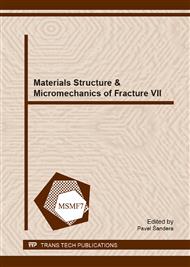p.141
p.145
p.149
p.153
p.157
p.161
p.165
p.169
p.173
Identification of Structural Parameters of Metal Fibre Concrete Using Magnetic Approach
Abstract:
Mechanical behaviour of concrete structures and their durability are conditioned by the reduction of cracking due to plastic and drying shrinkage and of permeability of concrete. This can be done using small metal particles, typically short steel fibres, randomly distributed in the concrete matrix. Since the technological requirements to the preparation and early-age treatment of such mixtures are rather demanding, some reliable a posteriori validation of expected solid material structure is needed. As alternatives to destructive testing, various low-invasive radiographic, electromagnetic, etc. approaches have been developed in the last decade. This paper demonstrates an original magnetic approach to the identification of volume fraction, macroscopic (in) homogeneity and orientation of particles in the matrix, using the Hall effect and the properties of solutions of the Laplace equation, as well as an advanced computational homogenization approach, coupled with the least-square based optimization technique.
Info:
Periodical:
Pages:
157-160
Citation:
Online since:
November 2013
Authors:
Price:
Сopyright:
© 2014 Trans Tech Publications Ltd. All Rights Reserved
Share:
Citation:


